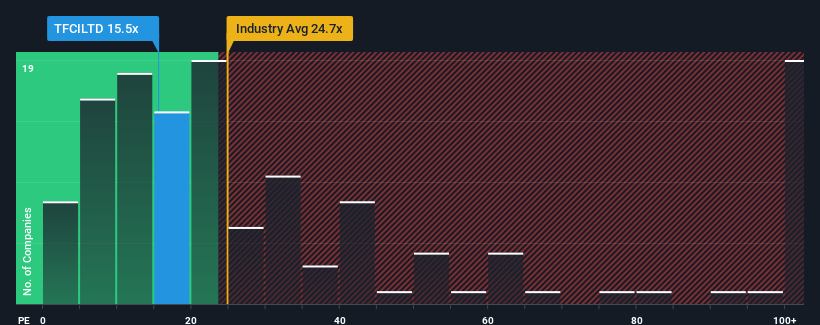- India
- /
- Diversified Financial
- /
- NSEI:TFCILTD
Tourism Finance Corporation of India Limited's (NSE:TFCILTD) Prospects Need A Boost To Lift Shares

When close to half the companies in India have price-to-earnings ratios (or "P/E's") above 31x, you may consider Tourism Finance Corporation of India Limited (NSE:TFCILTD) as an attractive investment with its 15.5x P/E ratio. Nonetheless, we'd need to dig a little deeper to determine if there is a rational basis for the reduced P/E.
Tourism Finance Corporation of India has been doing a good job lately as it's been growing earnings at a solid pace. It might be that many expect the respectable earnings performance to degrade substantially, which has repressed the P/E. If you like the company, you'd be hoping this isn't the case so that you could potentially pick up some stock while it's out of favour.
Check out our latest analysis for Tourism Finance Corporation of India

How Is Tourism Finance Corporation of India's Growth Trending?
In order to justify its P/E ratio, Tourism Finance Corporation of India would need to produce sluggish growth that's trailing the market.
Retrospectively, the last year delivered a decent 13% gain to the company's bottom line. However, due to its less than impressive performance prior to this period, EPS growth is practically non-existent over the last three years overall. So it appears to us that the company has had a mixed result in terms of growing earnings over that time.
Weighing that recent medium-term earnings trajectory against the broader market's one-year forecast for expansion of 26% shows it's noticeably less attractive on an annualised basis.
With this information, we can see why Tourism Finance Corporation of India is trading at a P/E lower than the market. Apparently many shareholders weren't comfortable holding on to something they believe will continue to trail the bourse.
The Final Word
Generally, our preference is to limit the use of the price-to-earnings ratio to establishing what the market thinks about the overall health of a company.
As we suspected, our examination of Tourism Finance Corporation of India revealed its three-year earnings trends are contributing to its low P/E, given they look worse than current market expectations. At this stage investors feel the potential for an improvement in earnings isn't great enough to justify a higher P/E ratio. If recent medium-term earnings trends continue, it's hard to see the share price rising strongly in the near future under these circumstances.
And what about other risks? Every company has them, and we've spotted 3 warning signs for Tourism Finance Corporation of India (of which 1 is potentially serious!) you should know about.
You might be able to find a better investment than Tourism Finance Corporation of India. If you want a selection of possible candidates, check out this free list of interesting companies that trade on a low P/E (but have proven they can grow earnings).
Valuation is complex, but we're here to simplify it.
Discover if Tourism Finance Corporation of India might be undervalued or overvalued with our detailed analysis, featuring fair value estimates, potential risks, dividends, insider trades, and its financial condition.
Access Free AnalysisHave feedback on this article? Concerned about the content? Get in touch with us directly. Alternatively, email editorial-team (at) simplywallst.com.
This article by Simply Wall St is general in nature. We provide commentary based on historical data and analyst forecasts only using an unbiased methodology and our articles are not intended to be financial advice. It does not constitute a recommendation to buy or sell any stock, and does not take account of your objectives, or your financial situation. We aim to bring you long-term focused analysis driven by fundamental data. Note that our analysis may not factor in the latest price-sensitive company announcements or qualitative material. Simply Wall St has no position in any stocks mentioned.
About NSEI:TFCILTD
Tourism Finance Corporation of India
A financing institution, provides financial assistance services in India.
Established dividend payer with proven track record.
Similar Companies
Market Insights
Community Narratives



